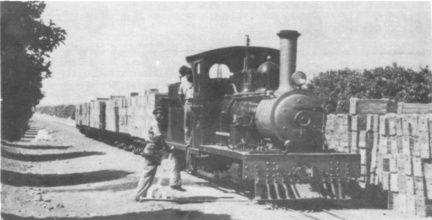
| THE INDUSTRIAL RAILWAY RECORD |
© JULY 1963 |
Letter to the Editor
_ _ _Dear Sir,
I found the article in RECORD No.1 on South African Industrial Locomotives most interesting as it recalled many personal observations made over a number of years in the 1940s. Certainly the size of the locomotive is most striking. The only small feature about 36" gauge locos is the length of the axles! It is difficult to believe that they are sub-standard gauge.
The unusually large number of main-line locos sold to industrial users in the colliery and goldmining areas provide the now remaining examples of many different classes. Two circumstances appear to have helped bring this about. The Netherlands South African Railway with a main line to Portuguese East Africa, and the Natal Government Railway with a main line to the Transvaal were originally worked by tank locos throughout. This soon changed after formation of the Union in 1911, when many six- and eight-coupled tank locos were available for sale at a time when the mining industry was expanding and new locos were not readily available elsewhere. Additionally, main-line locos were well suited to the very heavy work, often over lengthy private lines, and where space restrictions causing severe curves as we know them were virtually non-existent.
A study of the industrial locomotives of South Africa has contributed greatly to the building of an accurate record of the locomotive of that country. The first 36" gauge locos for Natal were 2-6-0 side tanks built by Beyer, Peacock in 1877 and one of this batch, no. 1706, was working at the East Rand Proprietary Mines after the Second World War, and may still be there.
Reference to the "narrow" gauge in South Africa means the 20" gauge. Industrially, the sugar estates of Natal provide the most examples but a few are to be found elsewhere. Again, they provided some interesting examples of old main-line locos, when the South African Railways could only offer Garratts.
Whilst visiting Northern Transvaal in October 1941 I was shown over the vast Zebedeila Citrus Estates, and noted an extensive 20" gauge system with flat trucks for carrying crates of fruit. There was no sign of motive power so I presumed that the trucks were manhandled. However, on leaving, I was astounded to see a steam loco come along and just had time to take a picture as it passed by. Time did not permit me to stay longer and follow it up. On examining the photograph later I found that the loco was almost certainly a "Lawley" engine. Now these locos have a most interesting history of which only a sketchy outline is known to me. They were 4-4-0 tender locos built by Falcon for the 20" gauge Beira - Umtali line in the 1890s, Lawley being the engineer in charge of construction. This line was soon converted to 36" gauge and the locos disposed of and all trace lost. During the first World War, the military authorities acquired some for work in South West Africa, passing them on to the South African Railways after the War was over. In later years they were to sell them again and we hear of one at a cement works, one at a timber concern in Rhodesia (see article in "Railway World", August 1954), and the one I saw at Zebedeila. Reliable information as to makers details or the total built is lacking. If anyone can add to this story it would be very welcome.
Yours etc.,
| CHEADLE, CHESHIRE. |
N. FIELDS. |

"Lawley" 4-4-0 locomotive at the Zebedeila Citrus Estates, North Transvaal, in October 1941 (N. Fields)